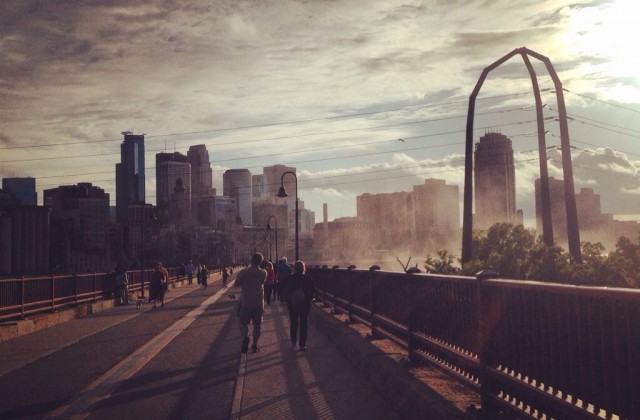Minneapolis: Not Run-of-the-Mill
I’m in Minneapolis today and, at the risk of turning this space into a travelogue, I have to share what I’ve experienced. The city is truly full of all the things we’re dreaming of in Seattle: sustainable use of resources, adaptive reuse, great design, density, transit choices, and affordability. All this from a city that is the Capitol of a region sometimes best known for it’s peculiar regional dialect and hard frozen winters.
Now I know from having read glowing reviews (ironically written by someone from here) that things can look really fabulous from the outside when the truth is much different. Seattle gets praise all the time for being innovative when those of us on the ground have other thoughts.
I’ll focus on the Mill District and I’ll cheat a bit by quoting Wikipedia.
In 1998, the City of Minneapolis enacted a Historic Mills District Master Plan, revised in 2000, to encourage development along the long-neglected stretch of riverfront. As a result, historic buildings were converted for adaptive reuse, bringing a residential population and offices to a neighborhood that beforehand had few residents.
The Mill District is unlike anything in Seattle. Think South Lake Union, Georgetown, the Ballard Locks, and Downtown combined. The Mill District hugs the Mississippi River and the falls, which are managed, like the Ballard Locks, by the Army Corp of Engineers.
The cross crossing bridges across the river and falls link together old mills that were the heart of a long gone industry. But…
Today, the Mill District has re-emerged as the historical and cultural center of Minneapolis. Many of the original flour mills have been saved and renovated into elegant loft homes and office spaces. The fortified ruins of the Washburn “A” Mill, once the largest mill in the world, has been transformed into the cornerstone of the Mill City Museum. Opened in 2003 this National Historic Landmark and museum features exhibits, artifacts, an observation deck, and boutique cafe. The renovated Milwaukee Road Depot is “a place for people again” with a popular ice rink in the old train shed. In 2006, the internationally acclaimed Guthrie Theater moved from its previous location near Loring Park. The MacPhail Center for Music moved its new campus to the neighborhood in 2007. The Mill City Farmers Market, an organic farmers market, was begun in 2006.
I got all around the whole area from downtown on a shared bike. I’d grab a bike for $6 a day, ride around, park at one of the many stations, stop, eat, look around, then grab another bike and go.
But here’s the takeaway: all of this was made possible by taking advantage of demand for housing and growth. Just like the mighty Mississippi turned the turbines for the mills, growth generated the financial investment to preserve the mills, create the public space, and support more housing in what was once an industrial area. People love the river and the falls. There is something about water that makes us want to linger, and people want to be around other people.
The lesson of the Mill District for us in Seattle is that we ought to use the gifts nature has given us, the appeal of our home, and the innovation of our people and our entrepreneurs to power us to new ways to have everything we want. We can do it! It’s the spirit of the wide open west and prairie: work hard, plan for the future, and welcome change.


